Every local family in Hawai‘i has their own version of fried rice. The Sugar + Shake household is no exception. The one I make is my mother’s recipe and includes carrots, celery, round and green onions, SPAM and bacon; a moderate amount of shoyu (soy sauce) and old rice. (Old, at least day-old, is key. I’ve made fried rice with fresh rice…but it’s not the same.)
Ingredient choice can be hotly debated. I had an ongoing argument with a good friend of ours over my insistence that celery was necessary (it adds crunch and a “fresh veggie” taste to counter the saltiness) and his contention that “celery sucks” and that peas were required. (Ew.) Some people feel that you need the same set of ingredients all the time, and others consider this a “use it up” dish and toss in whatever’s on hand.
I belong to the former school of thought. I’m such a stickler for it that I continue to put carrots in mine, a vegetable I despise, purely because my mother always put it in.
No matter what you put in it, local-style fried rice is always some shade of brown from the shoyu. It depends on the particular cook how brown it is. (And usually, the browner the rice, the wetter the texture of the rice, and the saltier the taste.) I go with a light tan because I don’t like damp and squishy fried rice. I also season liberally with garlic salt and pepper. That’s it.
Fried rice shows up as a side dish frequently (you can often opt to substitute fried rice for plain rice or other starches at diner-style restaurants), but we usually have it as a main dish at home. In which case, you’ve gotta have an egg on top! I insist on an over-easy or sunny-side up. Shake normally likes his eggs scrambled, but this is an instance where he’ll have a runny egg. Some people put scrambled egg into the rice itself (more on that later), but I don’t, so one or two eggs on top (depending how hungry we are) really makes it a complete dinner dish. (Although fried rice is usually a breakfast thing for us. You know, when we wake up at lunchtime.)
If you’re only familiar with Chinese restaurant fried rice, it’s different. A lot of times, Chinese fried rice has less shoyu than local-style Hawai‘i fried rice—it’s often very pale in color—and is more likely to have scrambled egg in it. American-Chinese fried rice almost always has frozen or canned peas-and-carrots mix in it. I hate that. My entire childhood, I made my mother pick out the peas and carrots before I’d eat it. (Yes, I was a spoiled kid. Wanna make something of it?)
I don’t generally make this style of fried rice (even without the peas and carrots), but one day we had a a lot of Chinese roast pork left over, so I decided to make Chinese Roast Pork Fried Rice for dinner. Besides the pork, I used SPAM, scrambled egg and round and green onions. (This Chinese roast pork is the crispy kind you see hanging in the windows of Chinese shops, not the red char siu pork that is often used in fried rice.)
Shake liked it so much, he now always offers to go to the Chinese take-out place to purchase the roast pork when we have a meal that includes it, and intentionally buys twice as much as I tell him to. “Oh, well, if we have leftover, you can make that fried rice thing…” (You’ll find the recipe after the recipe for our “regular” fried rice below.)
Fried rice is a pretty fast-and-loose affair. My mom never measured anything, and so I learned the recipe the same way. In fact, the first time I asked her how to make it, she emailed me a list of ingredients with the instructions, “Cut it like you always see me do it, and you know about how much I use.” That probably won’t help you much, seeing as how you’ve never watched my mom make this, so these are approximate measurements. Yours will never taste like mine, but that’s OK. Really.
Sugar + Shake Fried Rice
Old rice is best for fried rice. We store leftover rice from meals in the fridge until we have a big Tupperware full; ideally, it should be 2-3 days old, but at least one night in the fridge should dry it out sufficiently. As for how to prep the ingredients, as my mom said, “Do it like I do.” (Refer to the photos above and below.)
- 3-4 cups rice
- 5-6 slices bacon, sliced into ¼-inch wide pieces
- 3 ¼-inch thick slices SPAM, small-diced (¼-inch cubes)
- ¼ cup onion, diced (I like to use Maui or ‘Ewa sweet onion, but any yellow or round onion is fine)
- 3-4 stalks celery, cut into ¼-inch wide pieces (some people like to cut it on the bias into thin slices; that’s fine, too)
- ¼ to ½ carrot, julienned (you really could put more, but I—as mentioned previously—put the carrots in purely out of sentiment, and also to make it a bit prettier and more colorful. Do NOT by any means, use frozen or canned carrots. Ugh. That’s gross.)
- 3-4 stalks green onion, finely diced
- Approx. 1 tablespoon of shoyu (soy sauce; this is truly approximate—I’ve never measured it. I just pour it across the rice quickly and make an “X” or a fast circle, as in the photo. If in doubt, add a little at a time to get the desired shade. Too much and you’ll have really salty, really wet fried rice.)
- Garlic salt
- Pepper
- Egg
Prepare rice by crushing in your hands to separate the grains as much as possible.
Fry bacon pieces in a very deep frying pan—a wok (non-stick is totally fine) is best. When the bacon is fully cooked through and beginning to get crispy, drain off most of the grease. I use paper towels to soak it up. You want to leave a sufficient amount to fry the rest of the ingredients and prevent the rice from sticking — about two teaspoons.
Add the SPAM and fry until it begins to turn brown and crispy. Add all the veggies EXCEPT the green onions. Season liberally with garlic salt and pepper. Stir-fry until the onions turn translucent.
Add the rice and shoyu.
Mix together, using a wooden rice paddle (in a pinch, a plastic paddle will do, but I hate cooking with plastic utensils; my fried rice paddle is really the “spoon” half of a salad serving set) with a flat “slicing” and flipping motion. (Similar to how you would mix sushi rice.) Break up any stuck-together chunks of rice and make sure the shoyu is evenly dispersed throughout. (Nothing grosser than biting into a hard rock of shoyu-soaked rice.) Cook until the rice is heated all the way through.
Add the green onions and mix in, seasoning again with garlic salt and pepper to your taste.
Serve in bowls, topped with an over-easy or sunny-side up egg.
Chinese Roast Pork Fried Rice
This is a great way to use up leftover roast pork. Again, old rice is best.
- 3-4 cups rice
- Approx. 1 cup small-diced (¼-inch pieces) Chinese roast pork
- 3 ¼-inch thick slices SPAM, small-diced (¼-inch cubes)
- ¼ cup onion, diced (I like to use Maui or ‘Ewa sweet onion, but any yellow or round onion is fine)
- 1-2 cloves garlic, minced (optional)
- 3-4 stalks green onion, finely diced
- Approx. 1 teaspoon of shoyu (soy sauce; this is extremely approximate—you just want a little bit of flavor added, it shouldn’t turn the rice brown, or just barely.)
- 1-2 eggs, beaten
- Garlic salt
- Pepper
Prepare rice by crushing in your hands to separate the grains as much as possible.
Heat a very deep frying pan—a wok (non-stick is totally fine) is best—over high heat. When hot, add the roast pork and fry ‘til it begins to get crispy edges and the fat starts to melt. Drain off excess grease. You want to leave a sufficient amount to fry the rest of the ingredients and prevent the rice from sticking — about two teaspoons. Depending how fatty your pork was to begin with, you may not even need to drain off any oil.
Add the SPAM and fry until it begins to turn brown and crispy. Add the garlic, if using, and round onion. Stir-fry until the onions turn translucent and garlic becomes fragrant.
Push the meat and onions aside to create a little well in the center of the wok and scramble the eggs there. Once they’re set, mix in with the rest of the ingredients. Season liberally with garlic salt and pepper.
Add the rice and shoyu.
Mix together, using a wooden rice paddle (in a pinch, a plastic paddle will do, but I hate cooking with plastic utensils; my fried rice paddle is really the “spoon” half of a salad serving set) with a flat “slicing” and flipping motion. (Similar to how you would mix sushi rice.) Break up any stuck-together chunks of rice. Cook until the rice is heated all the way through.
Add the green onions and mix in, seasoning again with garlic salt and pepper to your taste.
Sugar + Shake Fried Rice










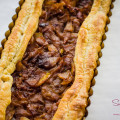
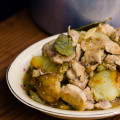
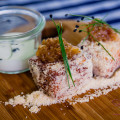
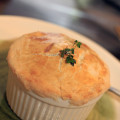

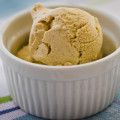

Melissa Chang
August 9, 2012 10:37 amThere used to be a hotly contested division in a place I used to work at: Are you a dry fried rice, or wet fried rice person? I’m more into wet fried rice. Also I don’t use shoyu…at the end of the frying process, I clear the middle of the skillet to create a well, then add a tablespoon of harmha & sugar. Then mix it in the heat of the pan, and mix it in with the rice. Super good! Stinks the kitchen for a few minutes, but so worth it!
sugar
August 10, 2012 7:10 pmI’m totally a dry fried rice person! That’s interesting about the non-shoyu technique. I’d heard of some people using oyster sauce or fish sauce. I bet the harmha would be awesome with the Roast Pork Fried Rice!